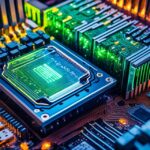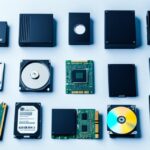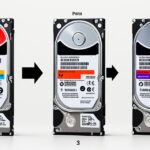Table of Contents
Named storage locations are crucial in organising and retrieving information in digital devices. In computer programming, an identifier names elements like variables and classes. Variables are special spots in computer memory that can change data during use, often saved in RAM.
These memory spots are carefully arranged through memory addressing. This sets areas for variable declaration, using the method data_type variable_name = value;1. This structuring is essential for how computers manage data.
By grasping memory types and identifier rules, we dive deeper into computer memory’s workings. It helps us see how computers work well in our complicated world. Knowing about named storage locations unveils the ways computing devices operate efficiently.
Key Takeaways
- Named storage locations are essential for managing data in computer memory.
- Identifiers must start with a letter or underscore and are case sensitive.
- Variables are dynamic, holding information that can change during program execution.
- Constants are immutable values that must be initialised at creation.
- The structure of memory addresses is vital for efficient data retrieval.
- Understanding memory allocation supports better programming practices.
What is Computer Memory?
The definition of computer memory refers to systems that store data temporarily or permanently. It’s vital for running programmes swiftly. It allows for fast information access, making computers quicker and more efficient.
Definition and Importance
Computer memory is essential in gadgets, helping store and access data. Its importance lies in boosting speed and efficiency. For example, RAM, a type of primary memory, disappears when there’s no power, unlike ROM. This affects how well apps and tasks run2.
Types of Memory Storage
It’s important to know the different types of memory to understand data flow in computers. Volatile memories, like SRAM and DRAM, have their uses. SRAM is faster but costs more, perfect for cache where speed is key2. DRAM, on the other hand, is cheaper and holds more data but is slower2.
Non-volatile memories, such as ROM and flash, keep data without power, ideal for long-term storage. Cache memory improves system speed by storing often-used data3. Moreover, HDDs and SSDs offer vast storage, vital for keeping big data volumes3.
| Type of Memory | Volatility | Main Features |
|---|---|---|
| RAM (Random Access Memory) | Volatile | Loses data when power is off; used for immediate processing |
| ROM (Read Only Memory) | Non-volatile | Retains data without power; used for firmware |
| Cache Memory | Volatile | High-speed access; reduces CPU delays |
| Flash Memory | Non-volatile | Used for data transfer and storage |
| HDD (Hard Disk Drive) | Non-volatile | Long-term storage; slower access |
| SSD (Solid State Drive) | Non-volatile | Faster than HDD; uses flash memory technology |
In conclusion, understanding types of memory is key to knowing how computers manage data. This affects their speed and how much they can store23.
This is a Named Storage Location in the Computer’s Memory
In the world of computing, named storage locations are key to memory’s work. These locations are made up of storage cells that store data. They’re uniquely identified to help find data quickly. This way of organizing data helps make computer systems run better.
Understanding Memory Locations
Memory locations are spots in the computer where data can be found. They have unique names like variables, functions, or structures, making them easy to spot during a program’s run1. Variables are examples of these named storage spots. They hold data that can change while the program is running. For instance, creating a variable such as int age = 20; sets aside memory for an integer. It tells the computer this spot holds integer numbers1.
Addressing Memory Locations
When programmers address memory locations, they give each spot a unique name. These names can have letters, numbers, and underscores but must start with a letter or an underscore. Important to note, these names are case sensitive and can’t have special symbols or spaces1.
Understanding how these locations are laid out helps programmers fetch data efficiently. This affects how well an app performs. When a variable changes, it directly affects the memory spot it’s linked to. Knowing this is crucial for great programming1.
Types of Computer Memory
It’s key to know the different kinds of computer memory to get how computers work well. Two main kinds are: cache memory and random access memory (RAM). Both are vital for speeding up access and improving performance.
Cache Memory
Cache memory acts as a fast temporary storage near the CPU. Being close helps it quickly access often used data, cutting down on data retrieval time from main memory. Cache can be part of the CPU or on a separate chip, making data transfer fast and increasing efficiency.
RAM and its Variants
RAM is crucial for storing data temporarily when a computer is running. It’s split into types like dynamic RAM (DRAM) and static RAM (SRAM). DRAM needs refreshing many times a second4, which makes it a bit slow. SRAM, on the other side, is quicker and uses less energy, keeping data as long as it has power4.
A modern laptop usually comes with about 8 GB of RAM and 250 GB of storage5.
| Type of RAM | Speed | Volatility |
|---|---|---|
| Dynamic RAM (DRAM) | Moderate | Volatile |
| Static RAM (SRAM) | Fast | Volatile |
DRAM is often used for main memory while SRAM is for cache. This shows the importance of knowing about different memory types to boost computer performance.
Understanding memory units and measurements gives more insight into computer memory management. It shows how cache memory and RAM make processing systems more efficient4.
Units of Memory
It’s vital to understand the different memory units in computing. This knowledge helps us know how data is stored and managed. These units range from bits to bytes, then kilobytes, megabytes, and gigabytes.
Bits, Bytes, and Words
A bit is the smallest storage unit in a computer, with a value of either 0 or 16. Bits group together to form a byte, which has 8 bits and stands for a character6. A word consists of bits, usually 32 or 64, depending on the system. In most modern computers, one memory location can store 1 byte7.
Common Memory Size Metrics
We measure memory size using kilobytes (KB), megabytes (MB), gigabytes (GB), and even terabytes (TB)6. For instance, 1 kilobyte is 1,024 bytes, useful for small files. A megabyte is about one million bytes, good for larger files6. A gigabyte equals 1,024 megabytes. Terabytes, at 1,024 gigabytes, are for vast storage needs in data centres6.
| Memory Unit | Size | Equivalent in Bytes |
|---|---|---|
| Bit | 1 | 0.125 |
| Byte | 8 bits | 1 |
| Kilobyte (KB) | 1,024 Bytes | 1,024 |
| Megabyte (MB) | 1,024 KB | 1,048,576 |
| Gigabyte (GB) | 1,024 MB | 1,073,741,824 |
| Terabyte (TB) | 1,024 GB | 1,099,511,627,776 |
As technology grows, knowing about these memory units is crucial. They help us understand data storage in everyday computing6.
Memory Hierarchy and Components
It’s important to know how primary storage and secondary storage fit into the data hierarchy. This helps us understand how computers work fast and efficiently. Every level of memory has a special job. This affects how quick a computer can get to data.
Primary and Secondary Storage
RAM functions and cache memory are part of primary storage. They let computers access data very quickly. Cache memory is usually smaller than 16 MB. Main memory can have less than 16GB8. On the other hand, secondary storage like HDDs and SSDs store a lot more data, over 100 GB. But, they’re slower at getting to that data8.
Registers and Cache vs. RAM
Registers are the speediest memory, sitting right inside the CPU. They have an access time of 0.25ns to 0.5ns8 and can transfer 20,000 to 100,000 MB per second8. Cache memory, taking 0.5 to 25ns to access, keeps the data you use a lot close by to speed things up8. When we talk about RAM functions, remember it takes longer, about 80ns to 250ns, to get to the data8. Moving up the memory hierarchy means it costs more per bit, but data comes faster9.
Here’s a table that shows the differences between these types of memory:
| Memory Type | Size | Access Time | Cost per Bit |
|---|---|---|---|
| Registers | Very Small | 0.25 – 0.5 ns | Highest |
| Cache Memory | Up to 16 MB | 0.5 – 25 ns | High |
| Main Memory (RAM) | Less than 16 GB | 80 – 250 ns | Moderate |
| Secondary Storage (HDD/SSD) | Over 100 GB | Slower | Lower |
Knowing the specific roles of each memory level helps us understand the whole system better. This knowledge is key to making computers work more efficiently and fetch data faster10.
Functional Analogy Between Human Memory and Computer Memory
Exploring how human memory compares to computer memory is quite fascinating. Both are crucial in handling information, yet they work differently. By looking at the human memory analogy, we gain a clearer understanding of computers. They mimic the way we think and process data.
Memory Encoding and Retrieval
How we remember things is key. For humans, it’s about turning what we experience into a format we can use mentally. This process has stages like encoding, storage, and pulling up memories11. Some memories form without us trying, while others require our full attention11. Computers also have their methods to store and access information. The way both systems retrieve memory shows similarities. They can both fetch data from different places, be it brain cells or computer storage.
Short-Term and Long-Term Memory Comparison
Diving into short-term and long-term memory, we see more similarities. Short-term memory is much like RAM in computers, holding information briefly. Long-term memory, on the other hand, is like a computer’s hard drive, where information stays for a long time12. The hippocampus deals with the immediate stuff, setting the stage for longer-term storage in the cortex12. This transition helps connect short-term to long-term memories, making sense of and accessing data easier.
Yet, the structure differs. Human memory is more flexible and interconnected. Computers are more fixed in how they store memory. Also, being skilled in a subject can influence how effective our short-term memory works11.
The Role of Virtual Memory in Modern Computing
Virtual memory is crucial in today’s computing. It makes memory management more efficient. Computers use it to extend RAM with disk space. This lets them multitask better and run bigger applications than the RAM usually allows.
Definition and Benefits
Virtual memory is a technique to make up for not having enough physical memory. Even computers with 8 GB of RAM can struggle with heavy tasks13. Virtual memory lets computers use up to four times their physical memory. This means users can run many applications at once without system crashes13. It uses smart ways, like paging and segmentation, to manage memory on the go14.
How Virtual Memory Operates
Virtual memory works by changing logical addresses into physical ones. It does this with hardware and software. With paging, it organizes memory into blocks, moving them between RAM and the hard drive when needed14. This includes Demand Paging, which brings pages into memory only when required. While this boosts performance, swapping between apps can be slow because RAM is faster than virtual memory13. The size of the computer’s hard drive also limits how much virtual memory can be used.
| Method | Description |
|---|---|
| Paging | Divides memory into fixed-size pages that are swapped between RAM and the hard drive |
| Segmentation | Divides memory into variable-sized segments that can be moved to disk when not in use |
| Demand Paging | Loads pages into memory only when needed |
| Page Swapping | Moves pages in and out of memory to free up resources |
| Thrashing | Occurs when too much time is spent on swapping instead of executing instructions |
Using virtual memory well can greatly enhance how applications perform. It also reduces problems caused by not having enough physical memory. Knowing how virtual memory works helps users optimize their systems14.
Good memory management is essential for keeping systems quick and responsive13. Experts suggest keeping virtual memory to no more than 1 ½ times the RAM. This avoids wear on SSDs and helps them last longer13.
Conclusion
Understanding named storage spots in computer memory is key for mastering modern computing’s challenges. We explored different memory types like RAM, cache, and virtual memory. They play big roles in how well and fast a computer works. By comparing human memory to computer memory, we see the clever ways both systems work. This comparison makes us appreciate technology and its growth even more.
Variables do more than just fill a need in programming; they are crucial for working with data and creating strong algorithms. Every program uses variables, showing how important they are in making code work. Variables can change as the program runs, which is important for making software that’s logical and functional1516.
To wrap up, getting the hang of how computer memory and variables work is super useful for programmers and tech fans. As new tech keeps coming, the basic ideas of memory storage and managing data stay key for making new, smart solutions in our digital age17.
FAQ
What are named storage locations in computer memory?
These are specific spots in computer memory that have their own addresses. They help manage, find, and organise data efficiently, which is key for the best computing performance.
Why is computer memory important?
It’s crucial as it allows quick data access and smooth program running. This greatly affects a computer’s speed and overall performance.
What are the different types of memory storage?
We have volatile memories like RAM, which need power to keep data, and non-volatile memories like ROM, which don’t. There’s also cache memory and secondary storage options, including hard drives and SSDs.
How does memory addressing work?
It gives each memory cell a unique address. This lets computers quickly find and get data. It’s vital for handling both user data and control information.
What are the roles of cache memory and RAM in a computer?
Cache memory offers fast access to data the CPU uses often, speeding up processes. RAM holds data for current tasks, helping the computer work efficiently.
How are memory units measured?
They’re measured in bits, bytes, and words. A bit is the smallest, with a byte being 8 bits. A word’s size can be 32 or 64 bits, depending on the computer’s design.
What is the difference between primary and secondary storage?
Primary storage like RAM and cache offers quick data access for running tasks. Secondary storage, including hard drives and SSDs, stores data long-term but is slower to access.
How does virtual memory enhance computing?
Virtual memory expands physical memory using disk space, helping with multitasking. It lets computers run larger programs than the RAM would usually allow.
Can you explain the analogy between human memory and computer memory?
This comparison shows how both systems handle information. Humans have short-term memory like a computer’s RAM for immediate tasks, and long-term memory which is similar to secondary storage, keeping data for extended periods.
Source Links
- https://www.cs.mtsu.edu/~xyang/2170/variable.html – Identifier, Variable, and Constants
- https://www.purestorage.com/au/knowledge/what-is-computer-memory.html – What Is Computer Memory | Pure Storage
- https://www.geeksforgeeks.org/computer-memory/ – Computer Memory – GeeksforGeeks
- https://medium.com/@hasonsnik/types-of-computer-memory-86bcc760550d – Types of computer memory
- https://www.techtarget.com/whatis/definition/memory – What is Computer Memory and What are Different Types?
- https://www.vaia.com/en-us/explanations/computer-science/computer-organisation-and-architecture/computer-memory/ – Computer Memory: Types, Units, Storage, Cache
- https://stackoverflow.com/questions/5215495/one-memory-location-in-a-computer-stores-how-much-data – One memory location in a computer stores how much data?
- https://www.geeksforgeeks.org/memory-hierarchy-design-and-its-characteristics/ – Memory Hierarchy Design and its Characteristics – GeeksforGeeks
- https://en.wikipedia.org/wiki/Memory_hierarchy – Memory hierarchy
- https://www.techtarget.com/whatis/definition/hierarchy – What is hierarchy (memory hierarchy)?
- https://opentext.wsu.edu/psych105/chapter/8-2-how-memory-functions/ – 8.1 How Memory Functions
- https://sandyp21.blogspot.com/2018/07/vocationaltraining-development.html – How is human memory similar to the computer memory? How is it different?
- https://www.techtarget.com/searchstorage/definition/virtual-memory – What is Virtual Memory?
- https://www.geeksforgeeks.org/virtual-memory-in-operating-system/ – Virtual Memory in Operating System – GeeksforGeeks
- https://pseudocode.deepjain.com/guides/vars/ – Pseudocode – Variables Guide
- https://www.vaia.com/en-us/textbooks/computer-science/starting-out-with-programming-logic-and-design-3-edition/chapter-2/problem-20-when-you-assign-a-value-to-a-variable-what-happen/ – Step by Step Solution
- https://www.upgrad.com/tutorials/software-engineering/c-tutorial/what-is-variables-in-c/ – Variables in C: All the Information You Require








